Below is a reprint of an article published in the August 2015 issue of Green Energy Times.
State of the World 2015: Confronting Hidden Threats to Sustainability
 From WorldWatch Institute, Island Press, 140 pages, $19.99
From WorldWatch Institute, Island Press, 140 pages, $19.99
Review by Tammy Reiss
This year’s publication by the WorldWatch Institute, State of the World 2015: Confronting Hidden Threats to Sustainability is well worth reading. Fourteen authors of the institute compiled the latest economic and scientific data along with their professional and personal perspectives on subjects not widely covered elsewhere. Among its articles are “Energy, Credit, and the End of Growth,” “Emerging Diseases from Animals,” and “Migration as a Climate Adaption Strategy.”
This volume moves the reader to rethink the status quo. One of the most obvious threats to sustainability is from energy as a driving force for our current economy, based on an incessant growth model and a gross domestic product calculation that considers neither the environment nor sustainability. Sobering information is discussed, as this quote shows:
Researchers estimate that detecting 85 percent of the viral diversity in mammals would cost around $1.4 billion or $140 million per year over 10 years. This is a small fraction of the cost of an emerging disease event (the 2003 SARS outbreak, for example, cost the global economy an estimated $30 billion-plus).
The volume discusses findings by scholars and scientists who study the economy, the Earth, and the interactions between them, and draws profoundly troubling conclusions.
It also brings to light a major sustainability threat from policy-makers and the voters who elect them. Officials at all levels of government have been responsible for picking technologies and infrastructure that quickly become outdated or inappropriate for sustainability. Unfortunately, the chapter dealing with this provides no example, though one comes easily to mind. We are building out gas infrastructure, on both federal and local levels, to accommodate expansion and gas’s use, despite the fact that it is just another dirty fossil fuel that will eventually run out. Our nation is switching coal-fired power plants, the trucking industry and entire communities over to natural gas, which ultimately is neither efficient nor sustainable, instead of utilizing sources of renewable energy.
This volume does not give all of the answers about why our kind is still acting to destroy our planet’s biodiversity for future generations, despite all of our governance, environmental impact assessments, and generally robust regulatory systems. Nevertheless, it will have you asking yourself, as the world passes environmental tipping points, how much longer our nation’s people will keep turning blind eyes to the need to have a sustainable society.
Tom Prugh, one of the project directors for Confronting Hidden Threats to Sustainability, says, “It is time for Homo sapiens to live up to its somewhat presumptuous Latin name, and grow up.”
Tammy Reiss is a conservationist and focuses her attention on the local region of central New York, where she lives. She teaches and promotes energy efficiencies and independence through renewables in the Marcellus Shale regions of New York State.








Leave a Reply